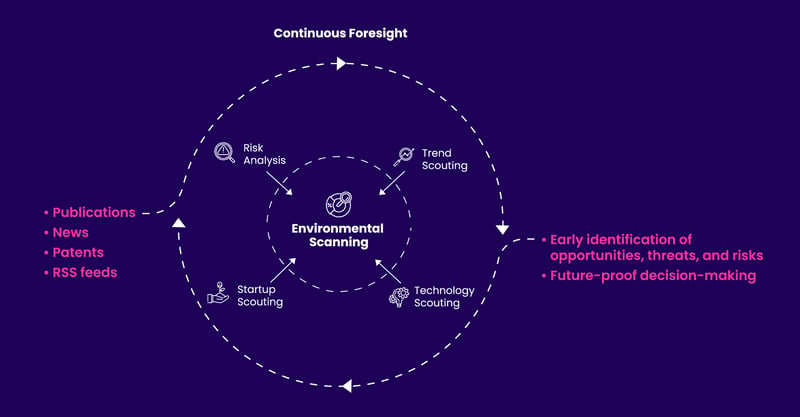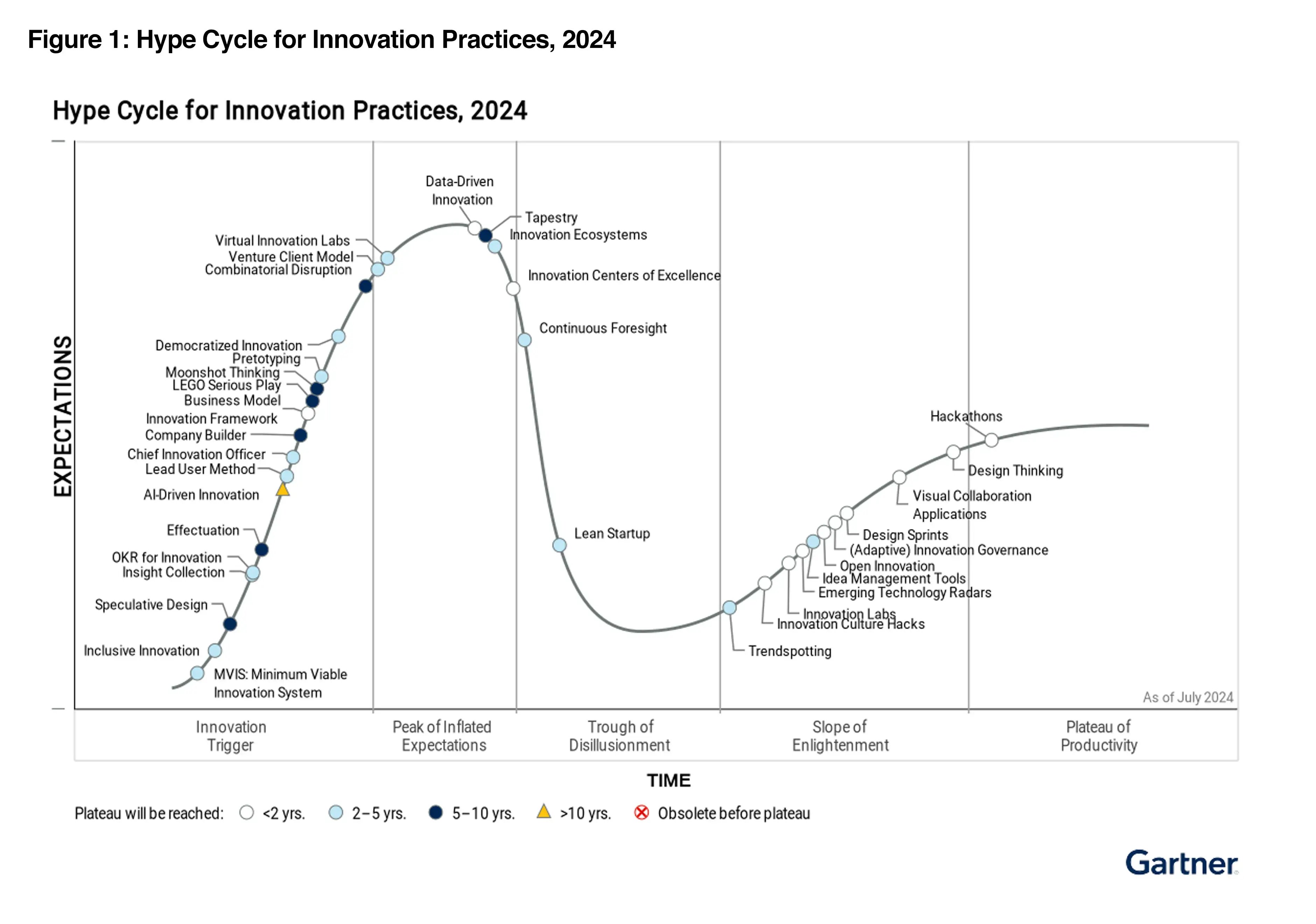Most companies do not have a defined process to track and respond to disruptions in the market. Foresight is a technique that helps you recognize changes in your business environment at an early stage so that you can prepare for the future. But let's be clear: an ad-hoc approach to foresight can lead to weakened strategic planning. The alternative is continuous foresight, a better approach to foresight that is more disciplined and consistent. Companies that adopt continuous foresight can respond faster to changes and gain a competitive advantage.
The myth of the crystal ball
Believing that foresight alone unlocks the secrets of the future is a fallacy. As Kara Cunzeman, Senior Project Lead for Strategic Foresight at The Aerospace Corporation aptly puts it in a recent interview:
The myth that foresight is the only answer to unlocking the secrets of the future is also a fallacy. It helps to open the mind, which helps to make better decisions. Still, there's always the element of surprise, which is a fact of life.
Foresight isn't a crystal ball—it's a strategic tool that expands our awareness and prepares us for what might come next. By enhancing our understanding of possible future scenarios, foresight enables organizations to become more resilient and adaptable. It's about making informed choices now to safeguard and strengthen your position in the face of uncertainty.
But while foresight sharpens our vision, it doesn't eliminate unpredictability. The goal is not to create an illusion of certainty, but rather to embrace uncertainty with greater agility. In a complex and volatile world, surprises are inevitable, and continuous foresight equips companies to pivot and respond effectively when the unexpected arises.
What is continuous foresight?
Not looking ahead has a cost. If you were a shaving company in 2011 and did not anticipate and respond to the trend of millennials growing beards, you helplessly would have watched as sales declined. But how do you know what you do not know? If you are unaware of a societal trend, you will not even know what word to research for.
This is where foresight tools come in. Foresight is about predicting what is needed in the future. But many companies take an ad-hoc approach to foresight; it may happen quarterly in strategic planning sessions. In contrast, continuous foresight involves relentlessly monitoring change and determining how to respond.

Continuous foresight requires a disciplined approach, a formal process to assess trends. Otherwise, your company’s innovation management may end up following one person's gut instincts instead of systematically proceeding based on credible data. In fact, that is a common pitfall. Many companies rely on single pieces of information. Internal biases influence their decision-making. Then there is unfounded optimism and expectations for big results, even though the company has no dedicated process for foresight. This disorganized approach is not a path to success. Disruptions to the market will catch you off-guard, like a bearded millennial.
The pitfalls of ad-hoc foresight
An inconsistent approach to foresight is just as dangerous as ignoring it altogether. Companies that engage in ad-hoc foresight often find themselves:
- Reactive instead of proactive: Always playing catch-up with market trends.
- Data-rich but insight-poor: Overwhelmed by information but lacking actionable strategies.
- Siloed thinking: Departments working in isolation, leading to fragmented strategies.
This disorganized approach is a recipe for failure in a world where agility and speed are paramount.
The competitive advantage of continuous foresight
Adopting continuous foresight isn't just about risk mitigation; it's a strategic weapon. Here's what it brings to the table:
- Early identification of future opportunities: Spot emerging trends before they become mainstream.
- Agile decision-making: Quickly adapt strategies based on real-time insights.
- Holistic viewpoint: Integrate technological, societal, economic, environmental, and political trends into your planning.
By embedding foresight into the organizational DNA, companies position themselves miles ahead of competitors stuck in reactive modes.
How to make foresight succeed in your organization
Implementing continuous foresight effectively requires intentional planning, execution, and ongoing evaluation. Here are the essential success factors for building a strong foresight capability:
- Commitment from leadership: Foresight requires a strong commitment from senior leadership to ensure a long-term vision. Leaders must dedicate time, resources, and support to make foresight an integrated part of the strategic process.
-
Building a diverse foresight team:
A successful foresight team brings together individuals with a range of skills—from trend analysis to strategic thinking. This diversity allows the team to gather insights from multiple angles, creating a more robust and adaptable foresight function. -
Engaging internal and external stakeholders:
Involving both internal departments and external partners ensures that foresight insights are grounded, relevant, and actionable. This collaborative approach strengthens foresight initiatives and aligns them with broader organizational goals. -
Embracing flexibility and adaptability:
The foresight process must remain agile, ready to adjust to new information or shifting conditions. Flexibility in approach enables the organization to pivot effectively when unexpected changes arise. -
Fostering continuous engagement:
Continuous foresight thrives on regular interaction with stakeholders across the organization. Ongoing engagement keeps foresight front and center, encouraging alignment and making insights actionable. -
Measuring the impact of foresight efforts:
Tracking and evaluating foresight outcomes are essential to demonstrate its strategic value. Measuring impact helps refine the foresight process and ensures it continues to deliver benefits aligned with organizational objectives. -
Utilizing the right tools and technology:
Effective foresight depends on the right tools, from trend analysis software to scenario planning platforms. Leveraging advanced technology simplifies data analysis and helps teams visualize and communicate insights effectively.
Gartner's perspective on foresight
Gartner has consistently emphasized the strategic value of continuous foresight, recognizing it as a transformative approach for organizations navigating an increasingly complex landscape.
In the 2024 Hype Cycle for Innovation Practices, Gartner positions continuous foresight in the “Trough of Disillusionment,” indicating that while the initial excitement around it has tempered, it remains on a steady path toward maturity. According to Gartner, continuous foresight is expected to reach the mainstream adoption plateau within the next 2-5 years.
For several years, Gartner has spotlighted ITONICS as a sample vendor for continuous foresight, acknowledging our role in advancing this critical practice.

Drive continuous foresight with ITONICS
How can your business survive in this changing world filled with uncertainty? You need to anticipate the future to thrive. Continuous foresight helps you envision plausible futures and plan for success. You can recognize drivers of change at an early stage and respond to these changes earlier than your competitors. Foresight includes environmental scanning, which scans for signals of shifts in societal, technological, environmental, economic, and political landscapes. The next step is to connect the dots between those trends and turn the findings into actions for your company.
All of this may sound intimidating. How are you supposed to keep track of so many forces that could mean success or failure for your business? Luckily, there are digital tools such as ITONICS Foresight that can help make continuous foresight manageable.
With ITONICS Foresight, organizations can:
- Identify market trends, emerging technologies, and weak signals.
- Use radar visualizations to track and assess drivers of change and prepare for change.
- Accelerate future opportunity discovery.
- Connect foresight to other steps of the innovation management process, such as ideation and portfolio management.
- Start a company-wide foresight program today!











